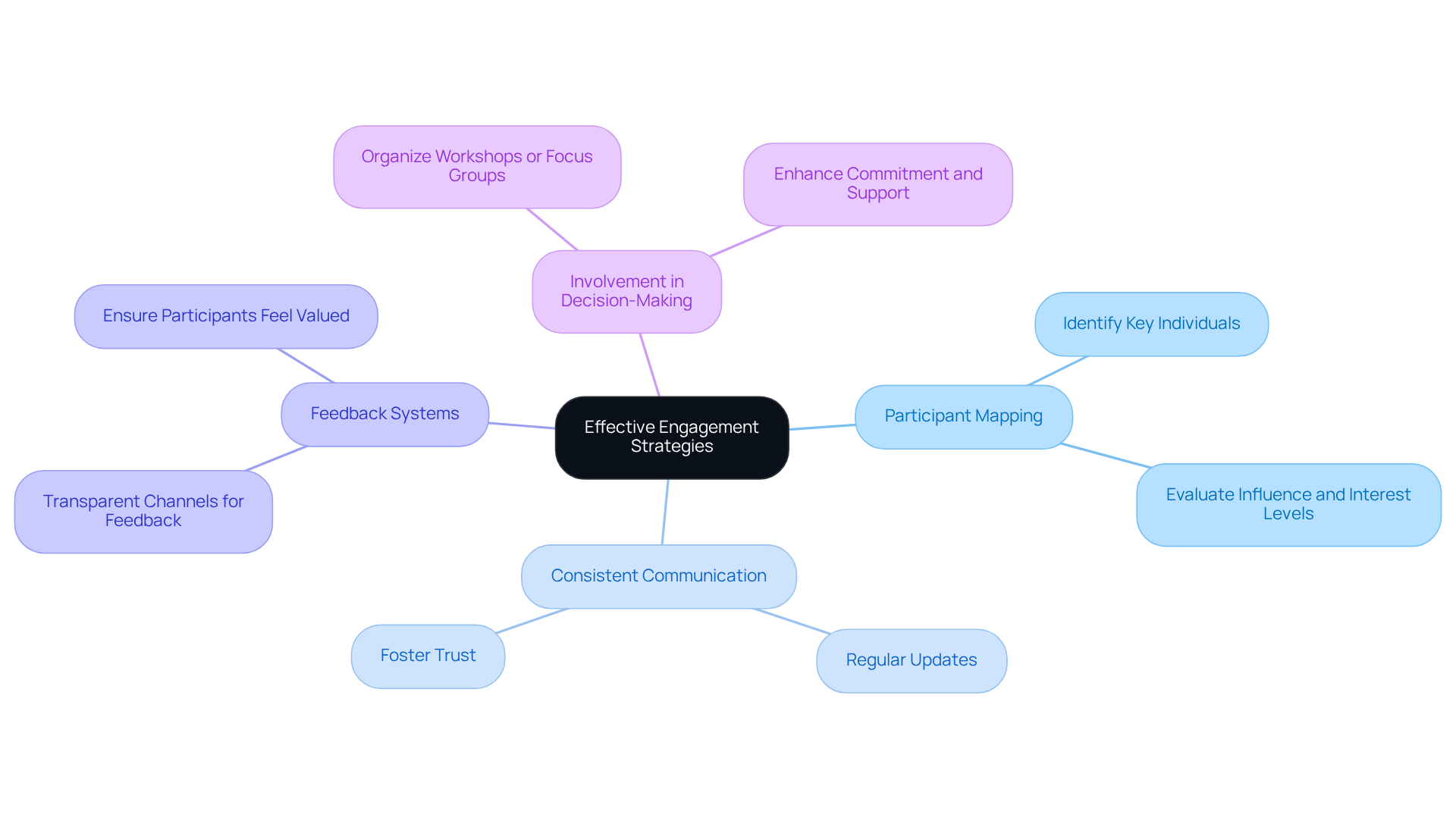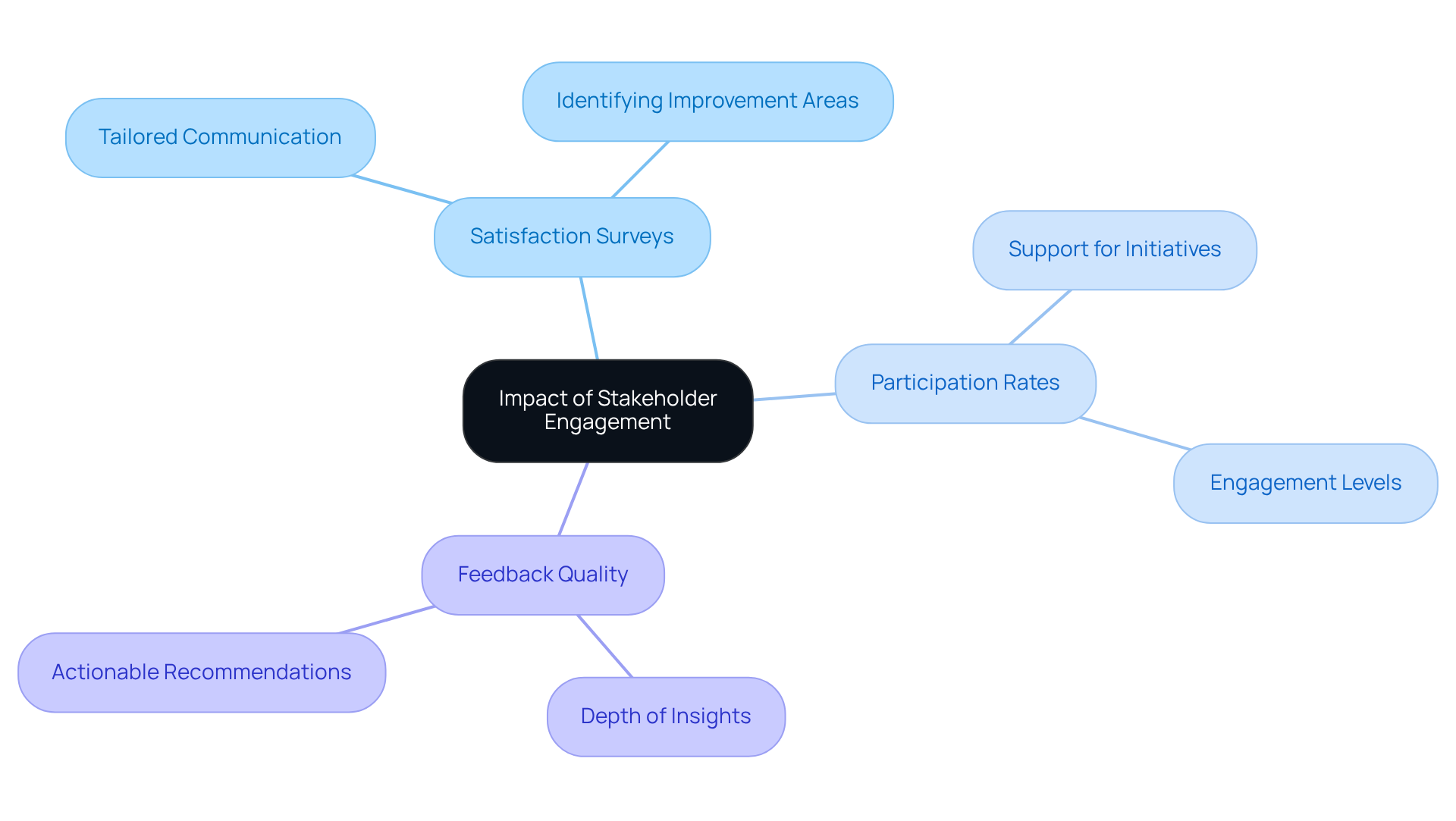Overview
This article delves into the essential objectives of stakeholder management, addressing prevalent misconceptions that often cloud its significance. It asserts that effective stakeholder management must prioritize the engagement of internal participants and foster ongoing communication. Data reveals that organizations with robust internal support consistently report higher success rates in their initiatives, underscoring the critical role of internal stakeholder involvement.
Introduction
Stakeholder management is crucial for the success of projects; however, many organizations struggle with misconceptions that impede effective engagement. By setting clear objectives that align with the SMART criteria, teams can improve communication and build trust among all stakeholders. A prevalent challenge is the misconception that stakeholder management is solely focused on external parties, often overlooking the essential roles of internal participants.
How can organizations transform their viewpoint to adopt a more inclusive strategy that not only dispels these misconceptions but also enhances project outcomes?
Define Stakeholder Management Objectives
Management objectives are critical for enhancing communication, fostering trust, and ensuring alignment between involved parties and project goals. Effective objectives must adhere to the SMART criteria:
- Specific
- Measurable
- Achievable
- Relevant
- Time-bound
For instance, a goal could be to increase participant engagement by 30% within six months through regular updates and feedback sessions. This approach is particularly vital for businesses, especially during crises, as it promotes transparency and collaboration.
Moreover, by leveraging Turnaround Consulting services—such as crisis resolution and transformational change through the Rapid-30 process—organizations can articulate these objectives with greater clarity. This preparation not only equips them to tackle challenges but also enhances support for successful outcomes.
Consequently, this strategy addresses immediate business concerns while laying the groundwork for long-term performance improvement through expert guidance and partnership.

Clarify Misconceptions in Stakeholder Management
Misunderstandings regarding participant management often lead to unproductive practices. A common misconception is [[[that plan stakeholder management](https://blog.smbdistress.com/why-stakeholder-management-does-not-include-any-planning-processes-essential-insights-for-cf-os)](https://blog.smbdistress.com/why-stakeholder-management-does-not-include-any-planning-processes-essential-insights-for-cf-os)](https://blog.smbdistress.com/why-stakeholder-management-does-not-include-any-planning-processes-essential-insights-for-cf-os) is fundamentally concerned with all the following except the crucial role of internal participants, primarily revolving around satisfying external groups. In fact, organizations with over 80% actively engaged sponsors report 40% more successful initiatives, underscoring the significance of internal support.
Moreover, 41% of underachievers cite insufficient sponsor assistance as a primary cause of initiative failure, highlighting that plan stakeholder management is fundamentally concerned with all the following except internal participant involvement. Additionally, many assume that party engagement is a one-time task; however, it is an ongoing process that requires continuous communication and adaptation to evolving needs.
By addressing these misunderstandings, groups can cultivate a proactive and inclusive management strategy, which plan stakeholder management is fundamentally concerned with all the following except achieving improved results. For instance, comprehensive management strategies that incorporate regular feedback loops and align with business objectives can significantly enhance success rates, as evidenced by the 73% of organizations employing formal management approaches that frequently achieve their goals.
The case of Coca-Cola's New Coke introduction serves as a cautionary tale, illustrating how neglecting the involvement of interested parties can lead to major project failures.

Explore Effective Engagement Strategies
Successful involvement tactics hinge on participant mapping, consistent communication, and robust feedback systems. Mapping interested parties is crucial for identifying key individuals and evaluating their influence and interest levels, enabling organizations to tailor their engagement strategies effectively. Regular updates and transparent channels for feedback not only foster trust but also ensure that participants feel valued and heard. Involving participants in decision-making processes significantly enhances their commitment and support for initiatives.
For instance, organizing workshops or focus groups allows participants to voice their concerns and actively shape the direction of the initiative. Research from the Project Management Institute indicates that initiatives with actively engaged participants are up to 70% more likely to meet their initial objectives, underscoring the importance of these strategies. Furthermore, companies that engage with interested parties are 30% more likely to succeed with new products, illustrating the tangible benefits of involving these groups.
By embracing such inclusive practices, organizations can cultivate a collaborative environment that promotes participant support and ultimately leads to project success.

Assess the Impact of Stakeholder Engagement
To evaluate the impact of participant involvement, organizations can utilize metrics such as:
- Satisfaction surveys
- Participation rates in activities
- Feedback quality
Examining these metrics enables entities to assess the effectiveness of their interaction strategies and identify areas for improvement. For instance, if survey results indicate low satisfaction among key participants, this may suggest the need for more tailored communication or increased involvement efforts. Moreover, monitoring changes in participant behavior, such as increased support for initiative efforts, can provide valuable insights into the effectiveness of involvement strategies. By continually assessing and refining their methods, companies can strengthen relationships with stakeholders and enhance project success.
Utilizing a Stakeholder Relationship Manager (SRM) platform can simplify the tracking and management of these connections. Establishing clear interaction targets, including metrics like subscription numbers and web traffic, is crucial for effective measurement. Additionally, organizations should recognize the challenges in developing standardized metrics for diverse stakeholder backgrounds, ensuring comprehensive data collection methods are implemented to provide a holistic view of stakeholder engagement.

Conclusion
Effective stakeholder management is foundational to the success of any project. It emphasizes the need for clear objectives and an understanding of common misconceptions. By prioritizing stakeholder engagement through well-defined, SMART objectives, organizations can foster better communication and collaboration among all parties involved. This approach not only addresses immediate project needs but also sets the stage for long-term success.
Throughout the discussion, key arguments have highlighted the importance of:
- Internal stakeholder involvement
- The ongoing nature of engagement
- The necessity of tailored communication strategies
Misunderstandings about stakeholder management can lead to significant project failures, as evidenced by the cautionary tale of Coca-Cola's New Coke. Conversely, organizations that prioritize comprehensive management strategies and actively engage their stakeholders are much more likely to achieve their objectives and enhance overall project outcomes.
Ultimately, embracing effective engagement strategies is not just a best practice; it is essential for cultivating a collaborative environment that leads to project success. Organizations are encouraged to actively assess their stakeholder management practices, address misconceptions, and implement robust engagement techniques. By doing so, they can unlock the full potential of their initiatives and ensure that all voices are heard and valued in the decision-making process.
Frequently Asked Questions
What are stakeholder management objectives?
Stakeholder management objectives are critical goals that enhance communication, foster trust, and ensure alignment between involved parties and project goals.
What criteria should effective stakeholder management objectives meet?
Effective objectives should adhere to the SMART criteria: Specific, Measurable, Achievable, Relevant, and Time-bound.
Can you provide an example of a stakeholder management objective?
An example of a stakeholder management objective is to increase participant engagement by 30% within six months through regular updates and feedback sessions.
Why are stakeholder management objectives important for businesses?
They are particularly vital during crises as they promote transparency and collaboration, helping organizations navigate challenges effectively.
How can organizations enhance their stakeholder management objectives?
Organizations can enhance their objectives by leveraging Turnaround Consulting services, such as crisis resolution and transformational change through the Rapid-30 process, which helps articulate objectives with greater clarity.
What is the benefit of preparing stakeholder management objectives?
Preparing these objectives equips organizations to tackle immediate business concerns while laying the groundwork for long-term performance improvement through expert guidance and partnership.




